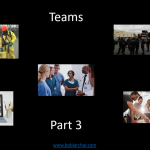Teams – part 3

Part 3 of a five-part series of posts around the subject of teams
In this part, I will look at what I consider to be the essence of a performing team.
Albeit each framework has its specifics; however, there are clearly commonalties between the different frameworks; words such as Purpose, Trust, Talent (or resources), Performance and Leadership appear regularly.
From my analysis of a multitude of approaches, I have identified 10 factors, each with descriptors that to contribute to high team performance
Purpose – the team has a clear & unified purpose:
- Team members understand why the team exists; there is a clear “raison d’être”
- The vision, mission and objectives of the team are accepted by everyone
- The objectives are meaningful to each team member.
- There is a collective accountability to achieve the team’s objectives
- Team failure is “collective” not “individual”
Governance – a mode of governance has been defined for the team:
- The team has taken time to explicitly discuss team process, how the team will function to achieve its mission and objectives
- Team norms for working together have been established and regarded as standard for every team member
- Team members understand the team’s processes and priorities
- The team regularly reviews its governance model to ensure continued appropriateness
- The team has developed a “repeatable” way of working while remaining agile
Roles – individual’s roles within the team have been clarified:
- Team members feel free to express their feelings on the tasks as well as on the team’s operation.
- There are clear expectations about the roles played by each team member.
- Work is fairly distributed among team members.
- Team members know and carry out their own roles and support & assist to others, as required
- Team members are not “role bound”
Performance – collective team performance objectives have been established:
- The team is clear on what needs to be done next, by whom, and by when.
- Team members understand that the accumulation of completed tasks leads to the effective and successful achievement of their final objective.
- Performance objectives are cascaded into well-defined concrete milestones against which the team measures itself
- The team regularly reviews its performance and objectives and alters its priorities and practice in the light of review.
- Team performance is more than a sum of individual performances
Leadership – leadership within the team is shared:
- The issue is not who controls, but how to get the job done
- Leadership shifts depending on the circumstances, the needs of the team, and the skills of the members.
- Leadership is used for collective benefits as opposed to individual benefits
- All team members use their leadership capacity
- The formal leader models the appropriate behaviour and helps establish positive norms
Communication – team members express themselves openly and honestly while respecting others:
- Team members use effective listening techniques such as questioning, paraphrasing, and summarizing to ensure understanding
- There is much discussion and everyone is encouraged to participate.
- Team members express themselves openly and honestly
- Team members build on each other’s ideas to come to conclusions
- Communication also takes place outside of formal team meetings
Cohesion – there is a clear sense of “we” within the team:
- Team members have a collaborative and collective commitment to achieve the team’s collective objectives.
- Individuals’ abilities, knowledge and experience are pooled and used by the team
- Team members are consistently supported and encouraged as a way of maintaining high levels of motivation
- There is a clear feeling of “we” within the team
- Team decisions are actively supported by all team members
Decisions – the team engages in shared decision making:
- There is a lot of discussion in which virtually everyone participates
- Disagreements are not suppressed or overridden by premature action
- Constructive criticism and encouragement are used by team members
- There are good processes for making, communicating, implementing and reviewing decisions
- Important decisions are made by consensus
Conflict – conflict within the team is considered an asset:
- Conflicts and disagreements are considered important to team decision.
- There is a willingness to work through difficult situations or conflict constructively.
- Disagreements that cannot be resolved, resulting in the need for compromises do not block the team’s efforts.
- Criticism has a constructive flavour; oriented toward removing an obstacle that the team faces
- The team is comfortable with disagreement and shows no signs of avoiding, smoothing over or suppressing conflict
Trust – there is a high level of support & trust within the team:
- Trust is created by open & honest communication and by consistent and respectful behaviour
- The team trusts the team leader and feels that it is led in an appropriate way.
- There is acceptance of each other’s’ strengths and weaknesses.
- People help each other by listening, evaluating, encouraging experimentation & giving support.
- Diversity of personal style is respected and embraced
The descriptors shown above can easily be converted into “audit” questions with which ‘spidergrams’ and the like can be produced to identify issues and action areas within the team
In part 4 I will look at the team development process
If you would like to discuss teams and their development do not hesitate to contact me at boblarcher@boblarcher.com